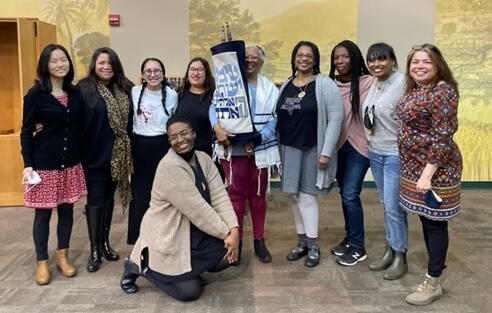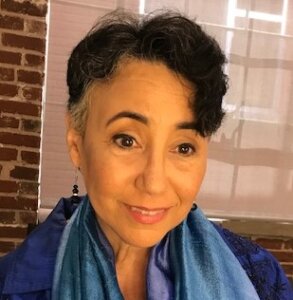National Shabbaton inspires Jews of color with the power of connecting as family
This year’s gathering drew 105 diverse Jews and allies from 12 states and the District of Columbia

Graphic by Angelie Zaslavsky
How far would you travel for a Shabbat service?
Last week, 105 Jews and allies from around the country gathered at the Pearlstone Retreat Center in Baltimore County, Md. What brought them together was the Second Annual Jews of Color Mishpacha Project Shabbaton, a gathering to build community through worship, meals, conversation, and recreational fun.
The shabbaton was created when Harriette Wimms, a licensed clinical psychologist who works with children, adolescents, adults, and families in Maryland, responded to 2020’s COVID-19 upheaval and lockdown with a vision of unity for Jews of Color.
“I was sitting in my living room in the midst of COVID isolation missing people,” said Wimms, who identifies as a Black queer Jew. She was inspired to create the Jews of Color Mishpacha Project to offer community workshops and gathering spaces. Then she posted on social media her desire to convene a gathering of Jews of Color in the Washington D.C., Virginia, Baltimore area. And the JOC National Shabbaton was born.
That first Shabbaton on May 14 – 16, 2021 was virtual, drawing some 450 participants from throughout the U.S., as well as Canada, Israel, and parts of Africa. Its success fueled Wimms’ determination to offer an in-person Shabbaton this year. After facing several challenges, including the date being pushed back three times, her vision was fully realized.
This year’s gathering, the “We Are Family” JOCSM Shabbaton, drew 105 diverse Jews and allies from 12 states and the District of Columbia together from May 6 – 8 at the Pearlstone Retreat Center in Baltimore County, MD to commune, worship, and celebrate together. They enjoyed activities for folks of all ages and denominations and services for all levels of observance, including Orthodox / traditional services with a mechitza. There were kosher meals and shomer Shabbat-friendly programs, plenty of outdoor activities, opportunities for solitude, activities for families with children, and affinity spaces for groups including LGBTQ+ JOC, Sephardi and Mizrahi Jews, white Jews, and elders.
“It was a brand-new experience for many, many people,” Wimms said. “Some folks flew on the redeye from California; others drove from Cincinnati. We had a 10-day-old baby, elders, toddlers, and teens. All denominations from Orthodox to Renewal. There were intense games of spades and some folks ordered 16 Kosher pizzas, delivered near midnight for the late-night crew. We ate, dreamed, rested, and rejoiced together. It was lit!”
Wimms said that a friend from California said to her at the Friday night dinner, “’When do we get this? When do we get to be the majority? Look around this room – this is so powerful!’”
Heather Miller, the president of Flatbush & Shaare Torah Jewish Center in Brooklyn, N.Y., found her first Jews of Color Shabbaton to be “spiritually fulfilling. There was a moment during services on Shabbat where I looked around, just soaking in the fact that many of us are usually the only ones or one of a few in Jewish spaces. Here we were all sitting, praying, enjoying space and community. It was like, wow, this is what it must be like for everyone else. I got chills.”
Eric Greene, a board member of the Jewish Multiracial Network, which lent its expertise in creating inclusive programming for families and children to the Shabbaton, affirmed the event’s value. “It felt wonderful to be with so many folks fully rooted in and embracing their identities as Jews and as People of Color,” he said. “There was no questioning of whether we belong, just recognition that we are.”
Wimms said she especially enjoyed watching all the children sit together and make family. And she continues to receive inspiring feedback about the event. “I got a text from a Jew of Color who came with her sister and her sister’s children. When they got home, her oldest niece said, ‘I want to be Jewish now, Mom,’ because they saw that Judaism wasn’t about whiteness. That is one of my goals,” Wimms said. “We absolutely had allies and accomplices – white Jews and non-Jewish POC and we all came together. People were hungry for connection with other Jews of Color. It was mighty powerful.”
Greene noted the impact of that power. “So many Jews of Color are coming into our own and finding a collective voice in community,” he said. “Not just saying that we exist, but also that we have something to contribute to the understanding of text and tradition. And that racial equity cannot be a marginal issue for the larger Jewish community. It must be central.”
After the 2021 Shabbaton, Wimms found her vision expanding. As her activism grew and she worked with several Jews of Color groups, she experienced the power of building community and forming alliances with similar organizations. Simultaneously, Wimms had recently joined the board of Pearlstone, an agency of The Associated: Jewish Community Federation of Baltimore. Its leadership had just secured a new multi-year grant to expand Jewish family camps from the Foundation for Jewish Camp.
This inaugural weekend was a JFAM Family Camp Program, built in partnership between the JOC Mishpacha Project and Pearlstone. To ensure a broad and inclusive event, Wimms engaged a diverse group of leading JOC organizations from across the country as partners and collaborators, including the Jews of Color Initiative, Keshet, Khazabar, Mitsui Collective, Jewish Multiracial Network, Jewtina y Co., Edot, Ammud, Avodah JOC BAYIT, JFNA’s Jewish Equity, Diversity, and Inclusion initiative, LAB/SHUL, TFE Transform for Equity, Atlanta Jews of Color Council, and Jews in ALL Hues. The weekend was also supported by The Blaustein Fund for Jewish Education.
Wimms stresses the necessity of bridging gaps in Jewish spaces. “We often hear that Judaism is in trouble,” she said. “We often hear that there are several younger Jews who are feeling disconnected from Jewish events and organizations. Jews of Color that I know are hungry across identification. Across all our differences, we were able to come together. Connection is what we all needed at this time.”
The main takeaway is the need to continue gathering, said Greene. “There is beauty and complexity in our Jews of Color community but so many of us are isolated physically from each other. We can really feel that beauty when we can come together. Like the ancient prayer says, it is good for us to dwell together.”
Wimms is planning a virtual retreat next January, and the next in-person Shabbaton for June 16 – 18, 2023. Some of this year’s participants are already planning to attend.
“It’s worth it to take the time out,” Miller said. “Despite the denominational differences, it was just amazing to be in a room together. Having conversations and talking about Halakah and studying Torah through our lens with a lot of denominations represented. We never have the opportunity to be in spaces like that. I say go!”
















